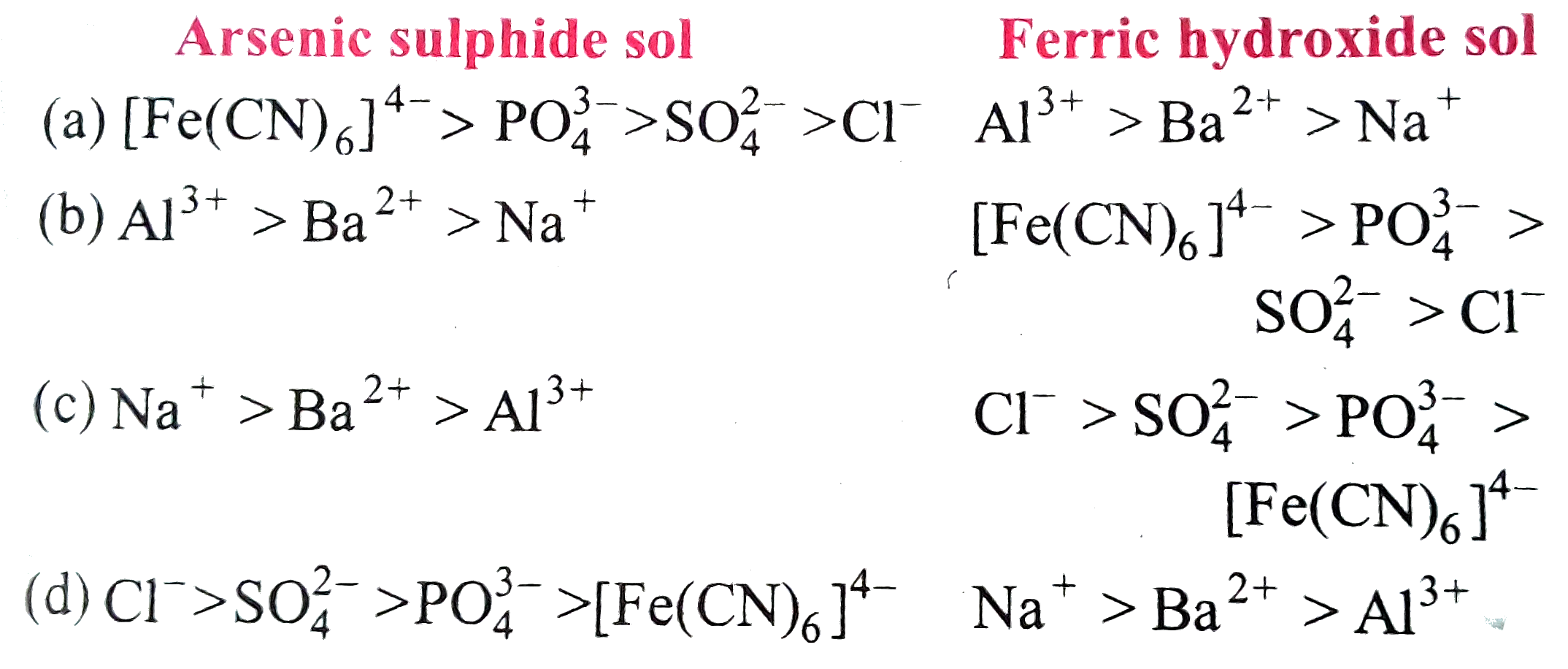Compared to common colloidal sols milcells have:
Higher colligative properties
Lower colligative properties
Same colligative properties
None is ture
The correct Answer is:B
To solve the question "Compared to common colloidal sols, micelles have:", we need to analyze the properties of micelles in comparison to common colloidal solutions, particularly focusing on their colligative properties.
1. Understanding Colligative Properties:
- Colligative properties depend on the number of solute particles in a solution, not on the nature of the solute. These properties include boiling point elevation, freezing point depression, vapor pressure lowering, and osmotic pressure.
Hint: Remember that colligative properties are influenced by the number of particles in solution.
2. Defining Common Colloidal Solutions:
- Common colloidal solutions consist of particles that range in size from 1 nanometer to 1000 nanometers. These particles are typically dispersed in a continuous phase (solvent).
Hint: Think about the size range of particles in colloidal solutions.
3. Understanding Micelles:
- Micelles are formed when surfactant molecules aggregate in a solution, typically when the concentration exceeds a certain threshold known as the critical micelle concentration (CMC). Micelles can also fall within the size range of 1 nanometer to 1000 nanometers but are generally larger due to the aggregation of multiple surfactant molecules.
Hint: Consider how micelles are formed and their structure compared to individual colloidal particles.
4. Comparing the Number of Solute Particles:
- In a common colloidal solution, the number of solute particles is generally higher than in a micellar solution because micelles consist of aggregated particles. Therefore, the effective number of solute particles contributing to colligative properties is lower in micelles.
Hint: Focus on how aggregation affects the number of effective solute particles.
5. Conclusion on Colligative Properties:
- Since colligative properties depend on the number of solute particles, and micelles have fewer effective solute particles compared to common colloidal solutions, micelles will exhibit lower colligative properties.
Hint: Relate the number of solute particles to the strength of colligative properties.
6. Final Answer:
- Therefore, compared to common colloidal sols, micelles have lower colligative properties. The correct option is Option 2: lower colligative property.
Summary:
- Common colloidal solutions have a higher number of solute particles compared to micelles, leading to greater colligative properties. Thus, micelles exhibit lower colligative properties than common colloidal solutions.
- Colligative properties depend on the number of solute particles in a solution, not on the nature of the solute. These properties include boiling point elevation, freezing point depression, vapor pressure lowering, and osmotic pressure.
- Common colloidal solutions consist of particles that range in size from 1 nanometer to 1000 nanometers. These particles are typically dispersed in a continuous phase (solvent).
- Micelles are formed when surfactant molecules aggregate in a solution, typically when the concentration exceeds a certain threshold known as the critical micelle concentration (CMC). Micelles can also fall within the size range of 1 nanometer to 1000 nanometers but are generally larger due to the aggregation of multiple surfactant molecules.
- In a common colloidal solution, the number of solute particles is generally higher than in a micellar solution because micelles consist of aggregated particles. Therefore, the effective number of solute particles contributing to colligative properties is lower in micelles.
- Since colligative properties depend on the number of solute particles, and micelles have fewer effective solute particles compared to common colloidal solutions, micelles will exhibit lower colligative properties.
- Therefore, compared to common colloidal sols, micelles have lower colligative properties. The correct option is Option 2: lower colligative property.
- Common colloidal solutions have a higher number of solute particles compared to micelles, leading to greater colligative properties. Thus, micelles exhibit lower colligative properties than common colloidal solutions.
Topper's Solved these Questions
- SURFACE CHEMISTRYBOOK - CENGAGE CHEMISTRY ENGLISHCHAPTER - SURFACE CHEMISTRYEXERCISE - Single Correct Answer Type
2 Videos
- SURFACE CHEMISTRYBOOK - CENGAGE CHEMISTRY ENGLISHCHAPTER - SURFACE CHEMISTRYEXERCISE - Exercises Assertion-Reasoning
17 Videos
- SURFACE CHEMISTRYBOOK - CENGAGE CHEMISTRY ENGLISHCHAPTER - SURFACE CHEMISTRYEXERCISE - Exercises Multiple Correct
25 Videos
- SOLUTIONSBOOK - CENGAGE CHEMISTRY ENGLISHCHAPTER - SOLUTIONSEXERCISE - Ex 2.3 (Objective)
9 Videos
- SYNTHETIC AND NATURAL POLYMERSBOOK - CENGAGE CHEMISTRY ENGLISHCHAPTER - SYNTHETIC AND NATURAL POLYMERSEXERCISE - Exercises Assertion Reasoning
10 Videos
Similar Questions
Knowledge Check
Assertion : Colloidal sol scatters light while true solution does not.
Reason : The particles in a colloidal sol move slowly than in a true solution.AIf both assertion and reason are true and reason is the correct explanation of assertion.BIf both assertion and reason are true but reason is not the correct explanation of assertionCIf assertion is true but reason is falseDif both assertion and reason are falseIn these colloids , a large number of small atoms or smaller molecules of a substance aggregate to form colloidal particles having size in colloidal range. These colloids are known as
Amultimolecular colloidsBmacromolecular colloidsCassociated colloidsDlyophilic colloids
The correct order ofr flocculating power of the given ions for the specified colloidal sols will be

View SolutionWhich one of the following colloidal solutions is postive sol ?
View Solution(a) Which will adsorb more gas, a lump of charcoal or its powder and why?
(b) Describe the preparation of the following colloidal solutions. Name the method used in each case:
(i) Silver sol (ii) Sulphur sol
View SolutionThe flocculating power of the given ions for the specified colloidal sols will be such that:
Arsenic sulphide sol Ferric hydro xide sol

View SolutionWhen dispersion medium is water, the colloidal sol is called:
View SolutionDuring the preparation of colloidal sol by Bredig's are method , traces of alkali (NaOH or Na2CO3) is added to
View Solution
